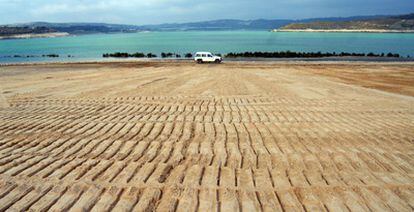Kayaking in an old mine
Endesa transforms a lignite works into a huge lake in A Coruña
The lake of As Pontes, in northern Spain, needs its water level to rise five more meters before becoming the country's largest artificial body of water inside an old lignite mine. Once those 40 million cubic meters of fresh water are in, Endesa will have completed an ambitious environment regeneration project. The abandoned mine will then be a reservoir with a surface area of 8.7 square kilometers, as big as the city center of A Coruña.
By law, the energy company had to restore an area it mined for three decades to feed the great thermal power station of As Pontes, which makes four percent of the electricity consumed by Spain.
The former mine is now a dark blue sheet with an artificial beach, two islets and impressive dimensions: 865 hectares in surface, an 18 kilometer perimeter and 206 meters in depth. It will hold over 547 million cubic meters of water, thus becoming Galicia's second-largest reservoir.
Endesa's director for the northwest region, Francisco Aréchaga, notes that the lake is nearly "at 93 percent capacity" following a very dry spring, and that he trusts it will be full "by late October or early November," almost half a year ahead of schedule.
Since January 2008, the reservoir has been feeding on the waters of the Eume river via a 3.3-kilometer canal that is closed off in the summer. When the autumn rains come, Endesa will reopen the conduit and completely fill up the old mine.
At that point, the lake will become the property of the regional government of Galicia, which plans to turn it into a tourist attraction through water sports such as regattas, kayaking or windsurfing.
The residents of As Pontes, which until 2009 held the uncomfortable record of being Spain's most contaminating municipality, now even have an artificial beach shaped like a half-moon with a 370-meter stretch of sand, in the shadow of the power station that still dominates the area's economy.
Engineers say that the water temperature in the summer will be around 23ºC, well above the 16ºC of the nearby beaches, which are washed by the Atlantic Ocean.
Endesa began exploiting the As Pontes mine in 1976. During 31 years, it extracted 261 million tons of brown lignite and another 813 million cubic meters of sterile residues. In the early 1980s, the company began seeking a way to regenerate that slag heap and fill up the enormous hole in the ground. After consulting with a German firm, it decided to copy the latter's technique for turning old Soviet sites east of Berlin into tourist lakes.
Aréchaga, who was formerly director of the mine, says that the giant project began taking shape in 1995 and cost over 35 million euros, as well as thousands of technical reports. "Flooding the space was the only feasible solution," says a spokesman for company management. Due to the characteristics of the soil and the heavy rainfall, the mine would have flooded anyway.
Meanwhile, from 1976 to 2007, Endesa had been piling up thousands of tons of useless residue that became a 160-meter-tall mountain filled with stone, ash and clay. Restoration work began in 1985 and ended 22 years later, with the planting of 600,000 trees and 120,000 kilograms of seeds in three million cubic meters of fertilized earth. The former slag heap has since been colonized by more than 170 animal species.
Every year, Endesa takes over 2,000 water samples from the reservoir and tests them for 22 different parameters, such as pH levels, iron and sulphates, to ensure it meets the Galician government's conditions. This surveillance has been going on for a decade.
There are already small banks of fish that came in through the canal and now swim around the two islets, which are still lacking names. The biggest one could end up being called Santa Bárbara, after the patron saint of mining.
The local government has entered this project in a European Union competition to find the best examples of environmental regeneration. But environmentalists are angry at what they call "the eternal sacking" of the Eume river by Endesa.
An activist group called Ríos con Vida (Rivers with Life) filed a complaint against the energy company for drying up a 3.4 kilometer stretch of the river since 1960. The attorney's office is investigating whether Endesa committed an environmental crime.











































